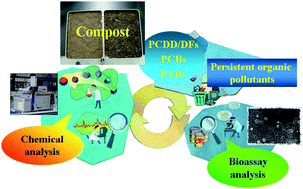Application of the dioxin responsive-chemical activated luciferase gene expression (DR-CALUX) bioassay to three compost products (kitchen garbage compost, treated sludge compost, and poultry manure compost) and their organic waste materials was performed for the screening of dioxin-like compounds. Phased sample preparation was conducted for the bioassay to yield separate crude, acid-stable, and carbon column fractions. Chemical analyses were also conducted for polychlorinated dibenzo-p-dioxin and dibenzofurans (PCDD/Fs), polychlorinated biphenyls (PCBs), and polyaromatic hydrocarbons (PAHs). Their determined WHO-PCDD/PCDF/dl-PCB-TEQ values were compared to the DR-CALUX results expressed as CALUX-TEQ to ascertain their contributions to overall activity. Overall all three compost products were polluted to a low level by persistent PCDD/PCDF/dl-PCBs in a few pg/g WHO-TEQ concentration range. The organic crude fraction showed non-persistent CALUX-TEQ values 2–4 orders of magnitude higher than those of WHO-TEQ. For the acid-resistant fractions of all samples, persistent CALUX-TEQ values were 1–8-fold higher than WHO-PCDD/PCDF/dl-PCB-TEQ values. Both TEQs correlated well for this fraction, which confirms the availability of CALUX for estimation of the actual WHO-TEQ level of the samples using reflux method with 44% sulfuric acid/silica gel, although the compost and material samples examined in this study contained much lower levels of WHO-TEQ: less than 1 pg/g in almost all cases. Additional carbon column treatment enhanced the potency and efficacy of CALUX activity in the three compost samples, which showed 1.6–4.4 times higher values of CALUX-TEQ than those obtained for the acid-resistant fraction. Although further DR-CALUX data collection for compost samples will be necessary, DR-CALUX is useful as a rapid screening method for monitoring dioxin-like compounds in compost.

You have access to this article
 Please wait while we load your content...
Something went wrong. Try again?
Please wait while we load your content...
Something went wrong. Try again?


 Please wait while we load your content...
Please wait while we load your content...